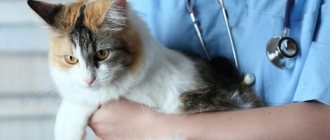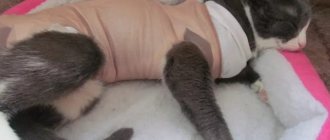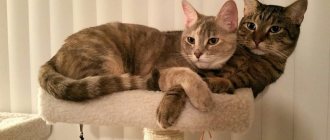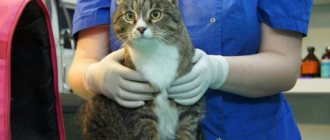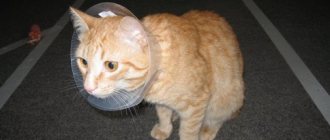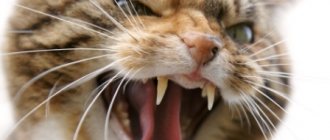To improve the quality of life of domestic cats suffering from dissatisfaction with sexual desire, castration is recommended. This surgical procedure, performed in veterinary clinics, is aimed at suppressing libido and eliminating sexual instincts in the animal. After castration, the cat becomes calmer and friendlier, stops marking territory in the house, tries to jump out of the window onto the street, meows loudly and spoils various things. In addition, castration reduces the risk of tumors and prostatitis in pets.
Castration of cats is carried out under anesthesia and involves making two small incisions in the scrotum area. The doctor tightens the spermatic cords and removes the testes, after which the wound is sutured and treated with an antiseptic. For an hour after the operation, the cat remains in the clinic under the supervision of a veterinarian, after which the owner takes the animal home, where it needs to be provided with full care provided for in the postoperative period.
In the article we will talk about the features of caring for a cat after castration, how and with what to treat the wound, when to remove the collar, how to feed correctly, when you can give water, after how many days the pet can be bathed, why a cat should not jump and lick the wound, what else is unacceptable to do after operation.
The first hours after surgery
If the cat was castrated in a clinic, then the pet must spend the first hour there. This is the most difficult moment: the animal comes out of anesthesia, and the veterinarian must make sure that everything happens according to plan - no complications are observed.
The second and third hours spent at home are still quite difficult. The cat has general weakness and dizziness. He is most likely thirsty, but also feels nauseous. And what is most important to a pet now is the love and attention of its owner.
We recommend reading the article about the behavior of a cat after castration.
Key points to pay attention to at this time:
- Drying of the ocular conjunctiva. During the operation, the pet's eyes remain open. The doctor regularly moistens them using special drops. At home, this procedure should be done by the owner, placing tetracycline ointment or a special “Diamond Eyes” solution under the cat’s eyelids.
- Decrease in temperature. Most likely, at first it will remain at 37 °C, which is two degrees below normal. Your pet may experience mild tremors from time to time. Therefore, it is better to place it in a warm place and cover it with a blanket. As a last resort, you can use an electric heating pad in a case or a hot water bottle wrapped in a towel.
- Impaired coordination of movements. Due to high muscle weakness, when trying to stand up or walk, the cat may stagger from side to side. It is better to try to persuade him to lie down with gentle persuasion. This will pass in a couple of hours, now the main thing is to make sure that your pet does not fall, especially from a height.
- Refusal to eat. The cat is unlikely to develop an appetite in the first hours. Abstinence now is only good for him. Otherwise, vomiting may begin.
- Painful sensations. It is advisable to ask your doctor in advance what painkillers you can use. Signs that a pet is suffering may include dilated pupils, pursed paws, and aggression when attempting contact.
General information
First we need to explain what castration is. Again, almost all breeders firmly believe that this is surgical removal of the testes. But it is not so. Yes, in most cases, veterinarians prefer to resort to surgical intervention. It is relatively simple, quick (under local anesthesia), and economically feasible.
But in fact, castration is divided into several types:
- Surgical. It can be open and closed (bloody and bloodless).
- Chemical. It is carried out by introducing special substances into the testes that promote the “drying out” of the gonads.
- Radiation. As you can easily guess from the name, it is carried out by irradiating organs with a directed beam of gamma radiation. Since the testes contain a lot of epithelial tissue, which is very sensitive to radiation, they instantly “break down”.
- Medication. A promising type of castration is carried out by surgically implanting special implants under the skin of the animal. Their cartridges gradually release special substances that help block the reproductive function of the animal.
All methods have their pros and cons. Some of the procedures can be performed at home, while others can only be performed in a clinic by a professional veterinarian. In short, there are a lot of nuances.
The features of caring for the animal in the postoperative period also depend on them. In some cases, the recovery period is long, but in others it takes a few days at most. Let's consider this issue in more detail.
Treatment of the surgical wound
During the first two weeks, the surgical area must be inspected regularly and checked to avoid bleeding or infection of the wound.
During the first week, to speed up the healing of the stitches, they should be treated with hydrogen peroxide twice a day and smeared with a solution of brilliant green. Later you can use iodine. In case of the slightest redness, you can lubricate the surgical area with Levomekol.
To prevent the cat from injuring the operating area, it is better to put a special collar on him for the first days. Otherwise, as a result of licking, the seams may come apart.
It is better to do the operation in winter or autumn. During this period, the likelihood of wound infection is less. During the summer, your veterinarian will usually prescribe a course of antibiotics for at least five days.
Rules and Important Notes
What other care recommendations should the owner consider? For the first few days, the operated cat should stay at home. This is not discussed. In addition, it is necessary by all means to prevent the pet from actively playing, as this is fraught with divergence of postoperative sutures (if any) and contamination of the scrotal cavity.
Under normal conditions, it is almost impossible to prevent this; the animal will still find time to lick. To prevent extremely unpleasant consequences, it is necessary to use a surgical (called Elizabethan) collar . You should monitor the integrity of this structure and ensure that your pet does not manage to remove it.
If your pet is “violent” and constantly tries to pull the collar off its neck, sedatives may be required. They will “control” the animal’s psyche: your pet will sleep more and stop (at least temporarily) its attempts. It should be remembered that he will have to wear a surgical collar for at least a week. And even after this period, you cannot remove it yourself: the cat must first be examined by a veterinarian. Only he can give/not give the go-ahead to remove the restrictive device.
Proper arrangement of the toilet is very important. Experienced breeders advise under no circumstances to use regular litter for the first few days: for this purpose it is necessary to use shredded paper. But not the newspaper! You can take regular toilet paper and tear it finely. This is necessary to prevent pieces of filler from getting into the wound canal. If this happens, severe inflammation almost inevitably develops, almost always purulent.
For a recently operated cat, all this can end very badly. At best, this means repeated treatment of the postoperative wound (and, most likely, another anesthesia), as well as an increased rehabilitation period. At worst, death due to acute sepsis; the development of gangrene and necrotic lesions of the organ is quite likely. Both of these conditions are characterized by a very strong pain response.
In addition, it is forbidden to wash or bathe your pet for six to eight days after the procedure, since contact with water containing detergents can also cause the development of an inflammatory reaction. Please note that the cat may feel pain in the operated areas for the first 48 hours, and this is also considered normal. But if signs of a pain reaction continue to persist after this period, it is necessary to urgently show your pet to a veterinarian. Most likely, something went “not according to plan”, inflammation or a hematoma developed. If you do not react in time, rehabilitation will take a very long time.
Toilet
As soon as the cat begins to stand up, it is necessary to place a litter tray with low sides near the bed. It is better to add a filler (silica gel is better, it does not create dust and dirt) that is light in color, so that you can immediately see if there is bleeding or pus.
If this is necessary, then on the first day you can use special diapers for cats.
If the cat avoids the toilet in the first days, this is understandable. Firstly, he had hardly eaten or drunk anything yet. Secondly, he experiences pain and discomfort and delays this moment. As a last resort, you can give your pet a little Vaseline oil.
It’s also okay if the cat goes to the toilet in small portions. This is normal for the first days. Within a month everything should be back to normal. And, most importantly, the urine will no longer have a pungent odor.
On the importance of regular monitoring of postoperative sutures
Even if there was no abdominal surgery, it is necessary to check the condition of the postoperative wound daily in order to monitor its healing process. Please note that for about 12-14 hours it will be somewhat swollen, reddened, and a small amount of transparent transudate may be released from the tissues. This is a completely normal, natural reaction of the body on the first day. There is no reason to worry: within about two days the swelling should subside on its own; the animal does not require any medical care. The exception is in individual cases when your attending veterinarian has given separate instructions and prescribed medications used to treat post-operative sutures.
Remember!! If within 48 hours the condition of the post-operative wound has not improved in any way, the swelling has become more pronounced and a mucous/purulent exudate has appeared, do not delay, call the veterinarian immediately.
Everything is completely bad when an unpleasant odor begins to emanate from the animal. This sign, coupled with severe swelling and redness of the wound, indicates contamination of the postoperative field with pyogenic and/or putrefactive microflora. If treatment is not started urgently, everything will end very sadly. And further. It should be taken into account that through the inguinal ring the “former” scrotum is directly connected to the pelvic cavity. With purulent-necrotic lesions of the scrotal sac, the likelihood of developing diffuse peritonitis is very high.
As a rule, in such cases, the animal is immediately prescribed broad-spectrum antibiotics and other antimicrobial drugs in loading doses. In particularly severe situations, repeat surgery may be required. So there is no need to delay contacting a veterinary clinic if your pet’s condition seems abnormal to you. Otherwise, you may lose your cat or spend a lot of effort and money on additional therapy.
Cat nutrition after castration
In the first hours and days, due to the effects of anesthesia and pain, the cat will not have time to eat. The main thing is not to force your pet to eat, this will only irritate him once again. Clean and fresh water should always be nearby. As soon as the nausea passes, the cat will quench its thirst.
Soon your appetite will return and, most likely, it will be increased. Overeating should not be indulged. Changes in hormonal levels can easily lead to obesity and related diseases. But if the cat refuses to eat two days after the procedure, this is an alarming factor. You need to contact a veterinarian.
As for the diet, it is better to gradually switch to special food for neutered cats or preventive food to prevent urolithiasis. If your pet is on a natural diet, remove fish and any food excessively enriched with calcium, phosphorus, and magnesium from the daily diet.
Dry food causes acidification of urine, which is also a prevention of urolithiasis, so this diet should be preferred. But drinking should always be plentiful. Read more in the article on what to feed a neutered cat.
Wound infections caused by licking
The main consequence of “rash” licking a wound is the development of wound infection. It is necessary to monitor your pet and notice in time signs indicating the presence of an inflammatory process.
The essence of the pathology is the proliferation of pathogenic and conditionally pathogenic microflora in the wound area. Even in the mildest cases, the presence of infection significantly slows down the healing process. The main signs that something is wrong are redness, swelling and a significant increase in local temperature. But this does not apply to cases where only two to three hours have passed after the operation.
If purulent discharge appears, you should immediately contact a veterinarian, regardless of how long ago the castration was performed. The consequences of delay are severe, including the death of the pet.
Mr. Cat recommends: possible complications
Typically, recovery after castration proceeds calmly, without deterioration of the condition. But you need to be aware of what cases may occur and be prepared for them.
Complications can be early or late.
Their first signs may appear on the operating table. They are expressed in bleeding and prolapse of the omentum or testes - the organs closest to the operating area. Good recovery care will help resolve this problem quickly.
Late complications are most often associated with wound infection. There may be several reasons - unsterile instruments, poorly treated surgical area, violations in postoperative care.
Symptoms that should cause concern to the owner:
- Increase in body temperature by more than two degrees above normal.
- Change in gait. They often say that the cat is experiencing pain and discomfort.
- Refusal to eat, apathy for several days.
- Increased thirst or refusal of water.
- Nasal discharge, sneezing.
- Pain when palpating the operating area.
- The cat has difficulty going to the toilet.
- Discharge from the wound in the form of pus and ichor.
- The pet's heavy breathing, shortness of breath, arrhythmia and tachycardia.
It is necessary to immediately contact the surgeon who operated on the cat and tell him about the alarming symptoms.
The most common complication, but nevertheless rare, is inflammation of the scrotum and surrounding tissues. If your pet has cryptorchidism, then this pathology is much more difficult for them to tolerate. Since the castration procedure itself was more difficult, because with this phenomenon the testes do not descend into the scrotum, and the operation becomes essentially cavitary. Usually the recovery period in this case is longer.
When to see a doctor
If during the recovery period, and especially on the first day, your pet exhibits the following symptoms, calling a doctor is required:
- heart rhythm disturbances;
- poor breathing, wheezing;
- swelling of the tongue, swelling of the eyelids;
- unnaturally pale/too bright color of the mucous membranes.
When interfering with a cat’s nature, one must not leave the consequences to chance. After all, it was not the cat who was interested in the advantages of castration, but its owner. Provide your pet with peace of mind and tender care, then castration will remain in the memory of a bad dream with a happy ending.
